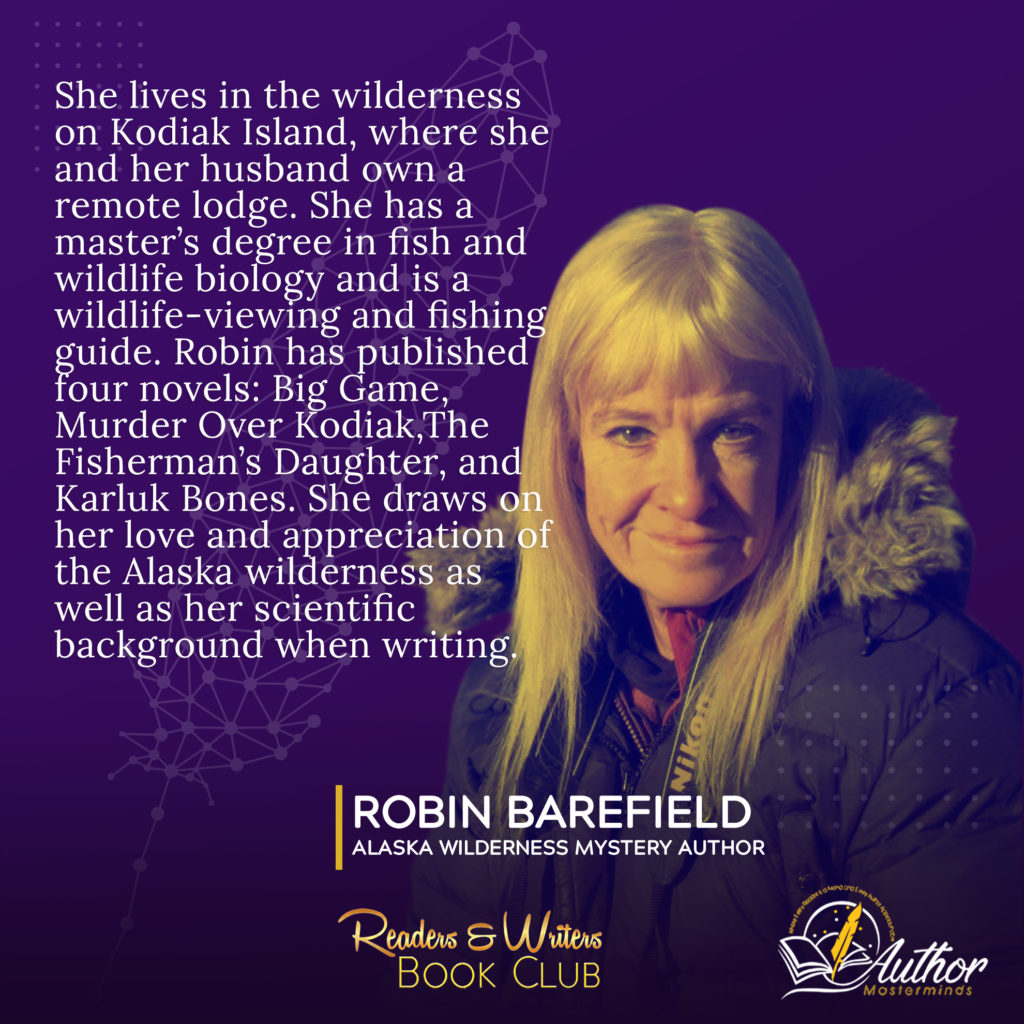
Robin Barefield
Alaska Wilderness Mystery Author
Robin Barefield resides in the wilderness of Kodiak Island, where she and her husband own and operate a remote lodge. She has published five novels—Big Game, Murder Over Kodiak, The Fisherman’s Daughter, Karluk Bones, and Massacre at Bear Creek Lodge—as well as two nonfiction books, Kodiak Island Wildlife and Murder and Mystery in the Last Frontier. In addition to her books, she writes a monthly true-crime newsletter about murder and mystery in Alaska. Holding a master’s degree in fish and wildlife biology, she also works as a wildlife-viewing and fishing guide. Her work has been published in scientific journals and by the American Public Health Association. She draws upon her deep appreciation of the Alaskan wilderness and her scientific background in her writing.
From an early age, Barefield aspired to be a storyteller, but her passion for science led her to pursue a career as a biologist. She has always been fascinated by both terrestrial and marine wildlife. After marrying and relocating to Kodiak Island to help run the lodge, she envisioned writing a book about the island’s wildlife, accompanied by her husband’s photography. The project took ten years to complete, and she remains immensely proud of the final work.
While engaged in that endeavor, she developed a passion for storytelling and began writing her Alaska wilderness mystery novels. For her, crafting mysteries is both an engaging challenge and a form of entertainment. She aims to create suspenseful and captivating narratives in which readers are given all the necessary clues to solve the mystery while still being surprised by the ending. Her novels are set in the environment she knows best: the Kodiak Island wilderness. Having lived there for four decades, she feels far more comfortable writing about this setting than about small towns or large cities. The dynamic forces of Kodiak’s wilderness—its shifting weather, geological features, and diverse wildlife—serve almost as characters in her novels. Given that 3,500 massive Kodiak bears inhabit the archipelago, encounters with these creatures frequently appear in her books.
Seeking to attract readers to her novels, Barefield launched a monthly Alaska true crime newsletter. True crime and Alaska are both widely appealing topics, making the project seem like an inspired and straightforward idea. However, she quickly realized the immense challenge of writing true crime and the unforeseen journey it would take her on.
With a love for research, she found the process of tracking down details on murders and mysterious disappearances both rewarding and demanding. However, writing about true crime proved to be not only technically but also emotionally difficult. These were real people—individuals who had been brutally assaulted or murdered—leaving behind grieving mothers, fathers, siblings, and children. Unlike fictional storytelling, true crime required a responsibility to honor the victims. On multiple occasions, she considered abandoning the effort, but over time, she felt a calling to lend a voice to those who could no longer speak for themselves. She also became more aware of the themes she wished to highlight in her true crime writing.
One of the most shocking revelations in her research was the extent of violence against women in Alaska, particularly Alaska Native women. The statistics were staggering, and she resolved to use every opportunity to share these troubling realities. The Violence Policy Center ranks Alaska among the most dangerous states in the U.S. for women. According to a 2020 University of Alaska Justice Center victimization survey, 60 out of every 100 women in Alaska have experienced intimate partner violence, sexual violence, or both. A 2016 report from the Violence Policy Center ranked Alaska first in the nation for the highest per capita homicide rate of female victims killed by male offenders.
Alaska Natives account for only 20 percent of the state’s population, yet Alaska Native women represent 54 percent of its sexual assault victims. Compared to other women in the U.S., they are ten times more likely to experience domestic violence. Barefield strives to present these statistics as accurately as possible while shedding light on the factors contributing to such violence, hoping her work might foster awareness and change.
Through her writing, she also aims to illustrate the complex cultural, political, geological, geographical, and climatological distinctions between Alaska’s regions. Many people outside of Alaska struggle to grasp the sheer size of the state. While Anchorage, Fairbanks, and Juneau have police forces, many small villages lack any immediate law enforcement presence, leaving residents to wait hours or even days for Alaska State Troopers to respond to a homicide.
Several years after launching her newsletter, she expanded her true crime writing into a podcast, Murder and Mystery in the Last Frontier, which is available on all major podcast platforms.
Ironically, while she initially pursued true crime writing to promote her wilderness mystery novels, the experience has significantly influenced her fiction. In her novel The Ultimate Hunt, hunters pursue human prey on a remote lodge island in the Kodiak Archipelago. The chilling concept was inspired by the real-life crimes of serial killer Robert Hansen, who flew his victims into the Alaskan wilderness, instructed them to run, and then hunted them down as if they were game animals. While the horrors depicted in The Ultimate Hunt may seem beyond belief, they are unfortunately rooted in reality.
Barefield hopes her novels and true crime stories both entertain and educate. Her protagonist, Jane Marcus, is a fisheries biologist studying the impact of climate change on North Pacific fish, whales, and other marine wildlife. As a biologist, Barefield is intimately familiar with this subject matter and hopes her readers find it as fascinating as she does.
For her, becoming an author has been the fulfillment of a lifelong passion for storytelling, and she cherishes every moment of the journey.

I so appreciate these frequent posts. They have expanded my world. I will definitely read Robin’s work.
Thank you